After a steep drop in deforestation rates since 2004, widespread fires in the Brazilian Amazon (September and October 2007) suggest that forest clearing may increase this year. All told, since 2000 Brazil has lost more than 60,000 square miles (150,000 square kilometers) of rainforest — an area larger than the state of Georgia or the country of Bangladesh. Most of this destruction has been driven by clearing for cattle pasture and agriculture, often in association with infrastructure development and improvements. Higher commodity prices, especially for beef and soy, have further spurred forest conversion in the region.
While drivers of Amazon deforestation are stronger than ever, mounting concerns over climate change and the effort to rein in greenhouse gas emissions may provide new economic incentives for landowners to preserve forest lands through a concept known as “avoided deforestation“.
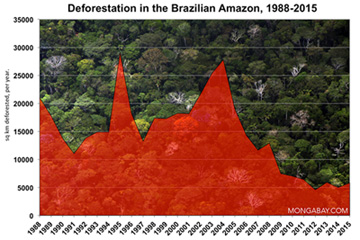 |
Avoided deforestation is the process by which owners, be they governments, communities, or landholders, sell the carbon rights to a given area to private investors. The private investor then sells the carbon credits on international markets to companies looking to offset their emissions. Under the existing Kyoto agreement, only reforestation and afforestation are eligible for carbon credits — forest protection is specifically excluded from receiving carbon credits — but considerable momentum for avoided deforestation makes it likely that the mechanism will be carefully considered during the next round of climate talks in Bali, Indonesia in December. Last month a group of eight tropical countries containing 80 percent of the world’s remaining tropical forest cover — Brazil, Malaysia, Papua New Guinea, Gabon, Cameroon, Costa Rica, Congo and Indonesia — announced an alliance to push avoided deforestation at the upcoming conference.
Given the possibility that carbon finance through avoided deforestation could become a reality, does it make economic sense for Amazon landowners to start protecting forest for carbon offsets rather than clearing it for cattle pasture, soybean farms, or board-feet of timber? Preliminary analysis suggest that yes, “carbon conservation” could be an attractive alternative to other uses of Amazon forest. Further, because standing forest confers ancillary benefits — including option value, biodiversity preservation, and other ecosystem services — avoided deforestation would do more than help mitigate climate change.
CALCULATIONS
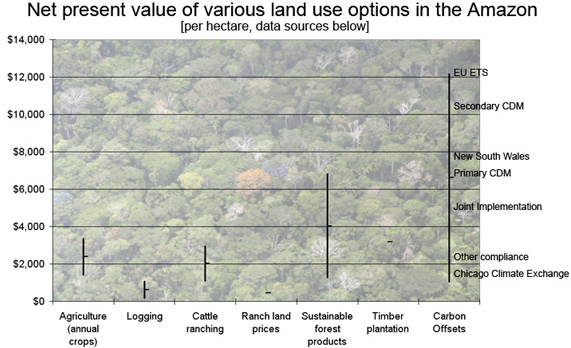
Carbon offsets versus other types of land use in the Amazon rain forest. |
The following is a rough comparison of carbon offsets to other forest uses — specifically industrial agriculture, cattle ranching, logging, timber plantations, and the harvest of sustainable forest products (which could continue to be conducted under “avoided deforestation” schemes). Please note that these figures will be updated as more data becomes available.
A word of caution: These figures are speculative. Many details need to be worked out before carbon finance through avoided deforestation (AD) becomes a reality. The fate of avoided deforestation will be determined at the December climate meeting in Bali.
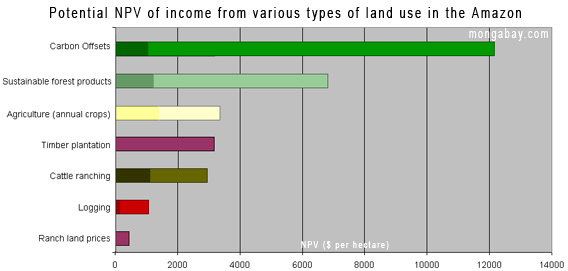
Another presentation of the scenarios. |
Carbon offsets
Because carbon offsets from avoided deforestation are not currently part of any legal emissions framework, it is difficult to anticipate pricing. For this exercise a range of prices are presented. These are based on 2006 real-world figures for various mechanisms — legally binding and voluntary; allowances and project-based transactions.
| Allowances | |
| EU ETS | $22.12 |
| New South Wales | $11.25 |
| Chicago Climate Exchange | $3.80 |
| Project-based transactions | |
| Primary CDM | $10.70 |
| Secondary CDM | $17.76 |
| Joint Implementation | $8.81 |
| Other compliance | $4.65 |
| Chart figures courtesy of the World Bank’s “State and Trends of the Carbon Market 2007” | |
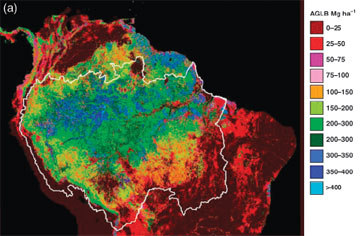
Aboveground live biomass (AGLB) class map of terra firme old growth forests derived from the decision rule classifier and multiple layers of remote sensing data. Courtesy of Saatchi et al 2007. |
Carbon storage in the Amazon depends on forest structure and vegetation types. In a 2007 Global Change Biology paper, carbon cycle scientists led by Dr. Sassan Saatchi reported that above ground biomass for old growth rainforest in the Amazon generally ranged from 150-350 metric tons of carbon per hectare (550-1283 metric tons of carbon dioxide equivalent [MtCO2e]). Above ground carbon storage in agricultural landscapes and pasture is considerably lower — generally well below 100 metric tons per hectare. Brown and Pearce (1994) suggest that net carbon released from deforestation of secondary and primary tropical forest, allowing for the carbon fixed by subsequent land use, is on the order of 100-200 metric tons per hectare (367-733 MtCO2e).
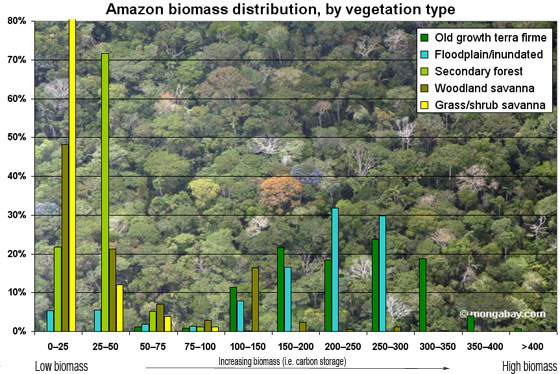
The biomass range (metric tons per hectare) for general vegetation types in the Amazon Basin. The authors report the following distribution of vegetation category for the basin: Old growth terra firme forest (62.3% of the legal Amazon [(8 235 430 sq km]); Floodplain and inundated forest (4.19%); Secondary forest (1.67%); Woodland savanna (24.47%); and Grass/shrub savanna (4.79%). The authors report average biomass ranges as follows: Dense forest 272.5 Mt/ha, Open forest 200.2 Mt/ha, Bamboo forest 212.3 Mt/ha, Liana/dry forest 189.7 Mt/ha, Seasonal/deciduous forest 225.6 Mt/ha, and Varzea flooded forest 248.3 Mt/ha. Image produced by Rhett A. Butler using data from the authors. |
Under the scenario presented, the cost of carbon offsets are assumed to be 25 percent of the proceeds in order to account for management feeds and funds held in escrow (to safeguard in the event of forest degradation or destruction).
Cattle
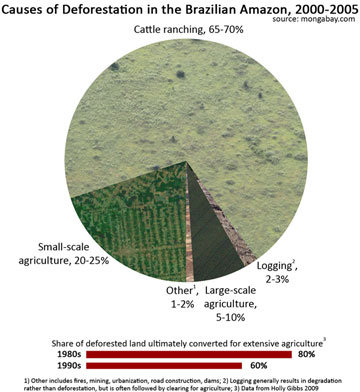
The above pie chart showing deforestation in the Amazon by cause is based on the median figures for estimate ranges. Please note the low estimate for large-scale agriculture. Between 2000-2005 soybean cultivation resulted in a small overall percentage of direct deforestation. more |
Roughly sixty percent of deforestation in the Brazilian Amazon can be attributed to land-clearing for cattle pasture. While much of this clearing is used for land speculation and as a hedge against inflation rather than cattle production, ranching is a profitable use of Amazon land. Today Brazilian ranchers can expect to net $80-110 per hectare, with an average return of 5 percent for cow calf operations and 8-10 percent for stockers. Earlier estimates — notably Dr. Charles M. Peters and colleagues in 1989 — put the net present value of cattle ranching closer to $3000 per hectare.
Breakeven Analysis: Assuming a carbon offset of 550 MtCO2e/ha of forest, the breakeven point for cattle ranching would be $2.00-5.38 per MtCO2e.
Logging
Returns from logging vary depending on how timber is extracted and what species are present. Typically, the high diversity of rainforest trees conspires to keep logging yields low: while hundreds of trees may be found in a single hectare, only a few will be of commercial interest. Estimates range from $156 to $1081 per hectare for reduced impact logging techniques to $600 per hectare using conventional logging (Almeida and Uhl 1995).
Breakeven Analysis: Assuming a carbon offset of 550 MtCO2e/ha of forest, the breakeven point for logging would be $0.28-1.97 per MtCO2e.
Timber Plantation
Peters et al. (1989) estimate the net present value of a Gmelina plantation at $3184 per hectare.
Breakeven Analysis: Assuming a carbon offset of 550 MtCO2e/ha of forest, the breakeven point for a Gmelina plantation would be $5.79 per MtCO2e.
Agriculture
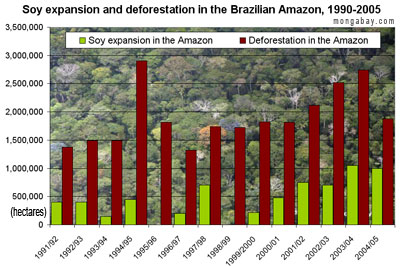
|
Industrial agriculture is increasingly viable in the Amazon due to improved crop varieties and technologies. Nevertheless, large-scale cultivation of annual crops requires heavy use of pesticides and fertilizers, driving up production costs. In the state of Mato Grosso, in the heart of the Brazilian Amazon’s agricultural boom, the U.S. Department of Agriculture (March 2007) reports that soy generates revenue of $1540-1650 per hectare. After costs ranging from $935-990 per hectare, farmers net $550-660 per hectare. Another estimate, from Almeida and Uhl 1995, suggests a net present value from $1400 to $3366, depending on whether the operation is sustainably managed.
Breakeven Analysis: Assuming a carbon offset of 550 MtCO2e/ha of forest, the breakeven point for agriculture would be $2.55-6.12 per MtCO2e.
Land prices
According to a local cattle rancher, prices for pasture land in Mato Grosso was around $450 per hectare in early 2007.
Breakeven Analysis: Assuming a carbon offset of 550 MtCO2e/ha of forest, the breakeven point for cattle ranching would be $0.82 per MtCO2e.
Sustainable forest products
Two widely-cited studies claim that the sustainable harvest of fruit, latex (rubber), timber, and other forest products can generate high returns for forest users. Grimes et al. (1994) found that non-timber forest products (NTFPs) at Jatun Sacha Biological Station in Ecuador could yield $1257 to $2939 per hectare. Peters et al. (1989) came up with a higher figure for a site on the Rio Nanay in Peru: a net present value of $6330 to $6820 per hectare.
Breakeven Analysis: Assuming a carbon offset of 550 MtCO2e/ha of forest, the breakeven point for cattle ranching would be $2.29-12.40 per MtCO2e.
CONCLUSION
These calculations suggest that from an economic standpoint, avoided deforestation could be a favorable use of land in the Amazon basin. Large-scale forest conservation for carbon offsets, combined with agricultural expansion on Brazil’s more than 50 million acres of degraded pasture, could pay dividends for forest stakeholders, the Brazilian economy and the global environment.
Note: the header image for this piece was updated in October 2020, replacing the low resolution forest picture with a higher quality picture.
